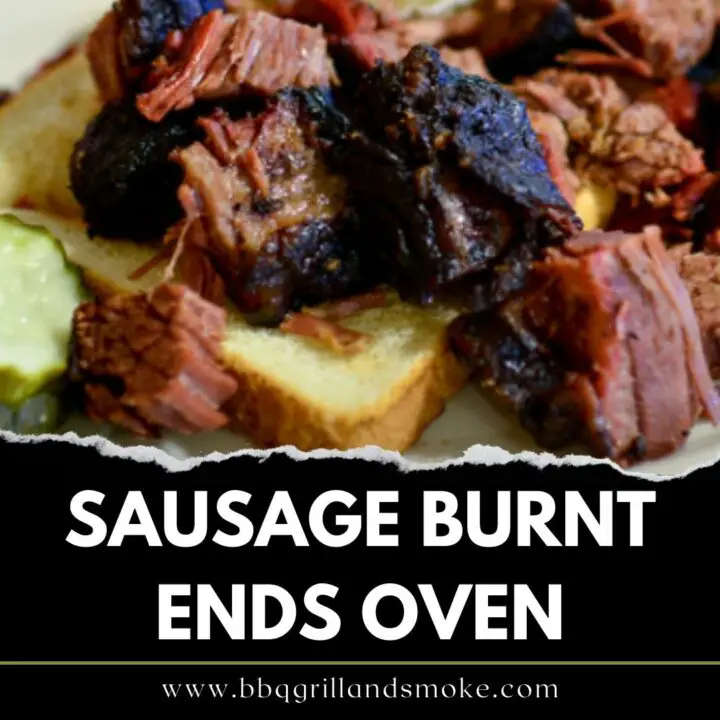Give up smoking and welcome the oven. Prepare to take over the world of sausage burnt ends oven style.
Who says you need expensive equipment to get those irresistibly sticky, smoky, caramelized bites?
You may discover the secrets of flawless burnt ends in your kitchen with this easy procedure.
This is your quick route to flavor; forget spending hours and hours over a smoker.

We’ll teach you how to turn regular sausages into spectacular burnt ends that are delicate and brimming with smoky deliciousness.
The secret is in the oven’s magic, a method so simple that even a novice cook can create these irresistible delicacies.
Now get your favorite sausages, preheat your oven, and get ready for a taste adventure that will have you licking your fingers and clamoring for more.
It’s almost time for the sausage burnt-ends oven revolution to start.
What Are Burnt Ends?
Meat that has been slowly smoked, diced, and caramelized—known for its sweet flavor and tenderness as butter—is called burnt ends.
Constructed from either brisket or pork belly, these are nearly as greasy as butter.
Burnt ends, despite their name, are not burnt. They appear charred due to their toothsome BBQ bark crust, yet they taste chewy and have a meaty, smoky flavor.
The combination of dry rub, smoke, and meat proteins causes a chemical reaction that results in the development of the flavorful “bark” known as barbecue.
What Are Smoked Sausage Burnt Ends?
Even though I enjoy smoking complete beef briskets, traditionally, burnt ends are formed from the pointed end of the meat.
However, these smoked sausage burnt ends are incredibly delicious and much simpler to make.
They’re a great way to use your smoker to create a flavorful appetizer that you can customize with your BBQ sauces and rubs.
Understanding the Food Science Behind Burnt Ends
Understanding the food science involved in burnt-end preparation is crucial to being a true master of the craft.
As the name implies, burned ends are typically created from the beef brisket’s fatty point.
Meat acquires moisture and tenderness from the cooking process when the collagen in the connective tissues transforms into gelatin.
The surplus fat renders, at the same time, the meat a flavorful coating.
Exploring Culinary Details
Let’s look at some important culinary tips that will make your burnt ends even better before we get in the kitchen.
Selection
Look for a well-marbled beef brisket when choosing one for burnt ends.
Good fat distribution is indicated by marbling, and this is necessary to achieve succulent tenderness and flavor.
Select a brisket that has a substantial layer of fat on one side; this will reduce the fat throughout cooking and guarantee a juicy result.
Cleaning and Preparation
Good preparation and thorough cleaning are essential to achieving the ideal charred ends.
- First, rinse the brisket in cold water and blot dry with paper towels.
- Trim off any excess fat from the surface, but take care not to remove all of the fat because it is essential to the flavor and texture of the dish.
- After that, generously rub in your preferred mixture of spices and seasonings. Combinations of paprika, brown sugar, salt, pepper, garlic powder, and onion powder are common choices.
- Before continuing, let the brisket sit at room temperature for at least half an hour.
Sausage Burnt Ends Oven
Embrace the oven instead of the smoker. Discover the keys to creating sticky, smoky, caramelized perfection in your own home with this recipe for sausage burnt ends baked in the oven.
Simple grocery materials and your trusty oven are all you need to turn ordinary sausages into spectacular bite-sized joy. No additional equipment is required.
- Course: Appetizer/Main (depending on serving size)
- Cuisine: American Fusion
- Prep Time: 15 minutes
- Cook Time: 1 hour, 30 minutes (including resting time)
- Resting Time: 30 minutes
- Servings: 4-6 (as an appetizer)
Ingredients
- 1 pound (450g) bulk of Italian sausage links, casings removed and crumbled
- 1 tablespoon of Dijon mustard
- ¼ teaspoon of onion powder
- A pinch of cayenne pepper (optional)
- ¼ cup (60 ml) of apple cider vinegar or apple juice
- ¼ cup (60 ml) of barbecue sauce (choose your favorite!)
- 1 tablespoon of tomato paste
- 1 tablespoon of Worcestershire sauce
- 2 tablespoons of brown sugar
- ½ teaspoon of smoked paprika
- ¼ teaspoon of garlic powder
Laid-Out Instructions
- Set the oven temperature to 350°F (175°C). To make cleanup easier, line a baking sheet with parchment paper.
- The crumbled sausage, brown sugar, Dijon mustard, tomato paste, Worcestershire sauce, paprika, onion and garlic powders, and cayenne pepper (if used) should all be combined in a big bowl. To evenly coat the sausage, thoroughly mix.
- Arrange the sausage mixture in a single layer on the baking sheet that has been preheated. To ensure even browning, bake for 30 minutes, stirring occasionally.
- In the meantime, mix the barbecue sauce and apple cider vinegar or apple juice in a small pot. Heat to a simmer on a medium setting.
- Pour the sauce over the sausage and toss to coat after 30 minutes. Lower the oven’s temperature to 275°F (135°C) and continue baking for a further hour, stirring every 15 minutes, or until the sausage is crispy and caramelized on the edges.
- Take the sausages out of the oven and give them a half-hour to rest. This facilitates the blending of tastes and further thickens the sauce.
The Dangers of Overcooking and Undercooking
When preparing burnt ends, it’s important to be mindful of the risks associated with both overcooking and undercooking, even though we all want the optimum doneness.
All your hard work could be undone by overcooking the meat, which would leave it extremely dry and tough.
Keep a careful eye on the internal temperature and execute routine doneness tests to prevent this. Recall that there is a thin boundary separating rubbery and tender.
Conversely, undercooking can leave charred ends chewy and unappealing.
Make sure you give it enough time to reach the right internal temperature so that the collagen can completely decompose and give the texture a melt-in-your-mouth quality.
What to Serve with Burnt Ends
Whether you plan to serve burnt ends as an appetizer or as the star of your entrée will determine what to serve them with.
Burnt ends are juicy and crunchy, and they’re a terrific addition to baked beans and other side dishes.
Find out what to eat with burnt ends below, whether you’re serving pork belly or brisket:
Serve Burnt Ends Between a Bun as a Sandwich.
Although they don’t remain in place and lay flat like sliced brisket, these savory morsels leak their juice into the bun, making for a sloppy yet delectable alternative to a barbecue sandwich.
Serve the Burnt Ends with Baked Beans.
Burnt ends give Kansas City-style baked beans their deep flavor; they become softer when stewed with these delicious, saucy baked beans.
Serve Burnt Ends with Carolina-style red Slaw.
Although Kansas City BBQ is known for its mayo-based coleslaw, we suggest breaking with convention and serving burned ends with the distinctive red vinegar-based Carolina coleslaw.
This light nicely complements the meaty, charred ends and acidic coleslaw seasoned with vinegar.
Conclusion
Welcome to the sausage burnt-ends oven revolution. Set aside the smoker and the bother.
The secrets to sticky, smoky, caramelized happiness can be found in your kitchen with this easy recipe.
Simple pantry ingredients and your trusted oven are all you need to turn regular sausages into extremely delectable bites without the need for expensive equipment.
Prepare for a taste adventure that will have you licking your fingers and hankering for more as you preheat your oven and gather your ingredients.
A symphony of sweet, smoky, and caramelized perfection awaits you in every bite of sausage burnt ends oven style.

Sausage Burnt Ends Oven Recipe
Give up smoking and welcome the oven. Prepare to take over the world of sausage burnt ends oven style.
Ingredients
- 450 grams of Italian sausage links, casing removed and crumbled
- 1 tablespoon Dijon mustard
- ¼ teaspoon onion powder
- A dash of cayenne pepper (if desired)
- 60 milliliters apple cider vinegar or apple juice
- 60 milliliters barbecue sauce (pick your preferred brand!)
- 1 tablespoon tomato paste
- 1 tablespoon Worcestershire sauce
- 2 tablespoons brown sugar
- ½ teaspoon smoked paprika
- ¼ teaspoon garlic powder
Instructions
- Preheat the oven to 350°F (175°C) and line a baking sheet with parchment paper for easier cleanup.
- Combine the crumbled sausage, brown sugar, Dijon mustard, tomato paste, Worcestershire sauce, paprika, onion and garlic powders, and cayenne pepper (if using) in a large bowl. Mix thoroughly to coat the sausage evenly.
- Spread the sausage mixture in a single layer on the preheated baking sheet. Bake for 30 minutes, stirring occasionally to ensure even browning.
- While the sausage bakes, in a small pot, combine the barbecue sauce and apple cider vinegar or apple juice. Heat the mixture to a simmer over medium heat.
- After 30 minutes, pour the sauce over the sausage and toss to coat. Reduce the oven temperature to 275°F (135°C) and continue baking for an additional hour, stirring every 15 minutes. The sausage should become crispy and caramelized at the edges.
- Remove the sausages from the oven and let them rest for 30 minutes. This allows the flavors to meld and the sauce to further thicken.
Nutrition Information:
Yield: 6 Serving Size: 1Amount Per Serving: Calories: 321Total Fat: 21gSaturated Fat: 8gTrans Fat: 0gUnsaturated Fat: 16gCholesterol: 43mgSodium: 778mgCarbohydrates: 18gFiber: 1gSugar: 14gProtein: 15g





